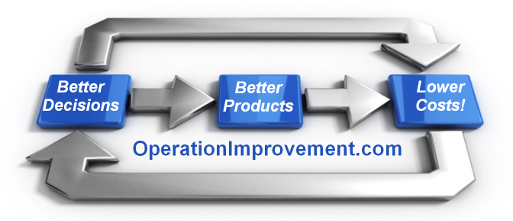Archive
Is it Cost of Goods or Operating Expense?
Expenditures should be filed in their proper category and proper month. These expenses typically show up in one of three places in the Profit and Loss (the P&L) Statement.
Imagine, for a moment, a business that buys cell phones for $1000. each and then sells those phones for $1000. 100 phones = $100,000 in Revenue (Sales). 1000 phones = $1,000,000. What is wrong with this picture? Only the cell phone maker makes money and the sales total is really their revenue and not yours.
Did you find a physical place or internet store where customers find it easier to do business? Was there special software or cosmetic customization of the phone? Are you obtaining wholesale prices because of your purchase volume? (You would be helping the manufacturer reach and service end customers!) No!
This nonsense example simply produces a grossly inflated “Revenue” number and, of course, is a recipe for failure.
If you add value with each sale from your inventory, you can mark up your cost. The selling price could be $1400. and the cost might be $1000., or even less with wholesale volumes. This margin of $400. is the Gross Profit on each phone, and this calculation needs to be reflected in the bookkeeping.
This is where cost of goods comes in. On a Profit and Loss (The P&L) Statement, that top line revenue number totalling $1400. for each sale is followed by a Cost of Goods line item. The $1000. cost of each phone is totaled into the Cost of Goods line item and then subtracted to show your Gross Profit.
This is an important concept because the top line revenue number essentially contains the sales total for both you and your supplier of inventory! This number soars with increased sales volume, but it is the Gross Profit, the Sales – Cost of Goods difference that actually gives you an accurate picture of the revenue you earned by adding value.
For more on Cost of Goods, see this article: Cost of Goods Sold (COGS) Explained With Methods to Calculate It (investopedia.com)
Ok. So what about those other expenses? Operating Expenses typically appear on the P&L immediately after Gross Profit. This will allow us to subtract those expenses from Gross Profit and calculate a Net Operating Profit.
Non-operating income and expenses typically have their own category, so that the P&L can show the health of the operating business with things like one-time income or expense items set to the side. Take a look at this discussion of operating and non-operating expense: Non-Operating Expense: Definition and Examples (investopedia.com)
There are several variations on this theme, and this web site** has some good examples of the different forms a P&L statement might take. Which one is most appropriate for your business?




